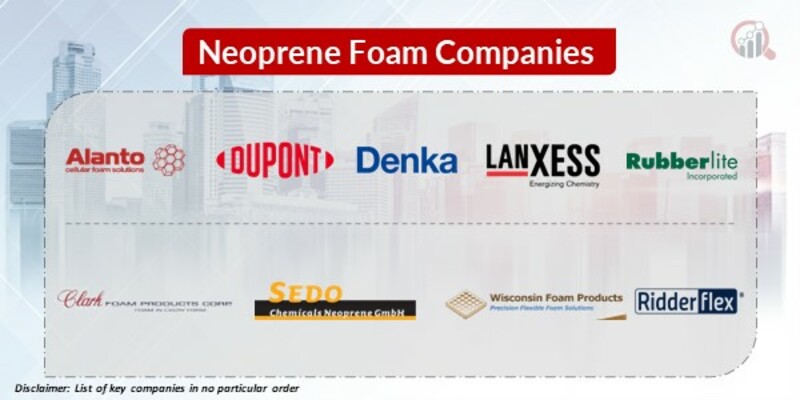Top Industry Leaders in the Neoprene Foam Market
Neoprene foam, a versatile synthetic rubber known for its water resistance, flexibility, and durability, finds applications across diverse industries. From wetsuits and gaskets to medical devices and automotive parts, its unique properties drive a thriving market. But beneath the surface lies a dynamic and competitive landscape, where established players battle it out with rising contenders. Let's delve into the strategies, factors impacting market share, recent industry news, and the latest developments shaping the neoprene foam market.
Strategies for Market Domination:
-
Product Diversification: Leading players like DuPont and Lanxess are expanding their portfolios beyond traditional closed-cell foam to include open-cell variants, lightweight options, and flame-retardant grades. This caters to a wider range of applications and strengthens their presence across different market segments.
-
Sustainability Push: Environmental concerns are prompting major players to adopt eco-friendly practices. Covestro, for instance, launched its "Neospan® eco" range made from post-industrial recycled neoprene, while Denka Company Limited focuses on utilizing bio-based raw materials. This resonates with environmentally conscious consumers and opens doors to new markets.
-
Vertical Integration: Integrating upstream processes of chloroprene production secures raw material supply and cost advantages. Companies like Shanxi-Nairit Synthetic Rubber Co. and Huizhou Wanhua Chemical are strengthening their vertical integration, giving them a competitive edge.
-
Geographical Expansion: Emerging economies in Asia Pacific with growing disposable incomes and booming construction sectors offer lucrative opportunities. Companies like Sundow Polymers and The 3M Company are aggressively expanding their production and distribution networks in these regions.
-
Innovation and Collaboration: R&D investments are crucial for sustained growth. Dow Chemical Company collaborates with universities and research institutes to develop advanced neoprene formulations with enhanced properties like self-healing capabilities. Such innovations differentiate players and create new market niches.
Factors Shaping Market Share:
-
End-User Demand: The automotive and construction industries remain major drivers, followed by the medical and sporting goods sectors. Fluctuations in demand from these sectors directly impact market share.
-
Raw Material Prices: Chloroprene, the primary raw material for neoprene foam, is subject to price volatility due to geopolitical factors and supply chain disruptions. Fluctuating prices impact production costs and profit margins, influencing market competitiveness.
-
Regulations and Environmental Concerns: Stringent regulations on chemical emissions and growing consumer preference for sustainable products push players towards eco-friendly alternatives. Companies with a strong focus on sustainability gain an edge in the market.
-
Regional Dynamics: Asia Pacific is expected to be the fastest-growing market due to rapid urbanization and industrialization. However, established players in Europe and North America maintain significant market shares thanks to strong brand recognition and technological advancements.
Key Companies in the Neoprene Foam market include
- Alanto Ltd.
- DuPont
- Denka Company Limited
- Lanxess
- Shanxi-Nairit Synthetic Rubber Co. Ltd
- FOAMTECH Ltd.
- Rubberlite, Inc.
- Clark Foam Products
- Sedo Chemicals Neoprene GmbH
- Lauren Manufacturing
- Wisconsin Foam Products
- Ridderflex
- Rubatex
- Williams Products
- GCP Industrial Products
Recent News
-
August 2023: Covestro and Lanxess announce a joint venture to develop and produce next-generation neoprene foams for the automotive sector, focusing on lightweight and fuel-efficient applications.
-
October 2023: The International Neoprene Producers Association (INPA) reports a 5% increase in global neoprene foam consumption in Q3 2023 compared to the same period in 2022.
-
November 2023: Zenith Rubber, a leading Chinese neoprene foam manufacturer, unveils its new line of medical-grade foams with enhanced bacteria-resistant properties.
-
December 2023: The European Union announces stricter regulations on the use of chlorinated solvents in neoprene foam production, posing a challenge for some manufacturers.












